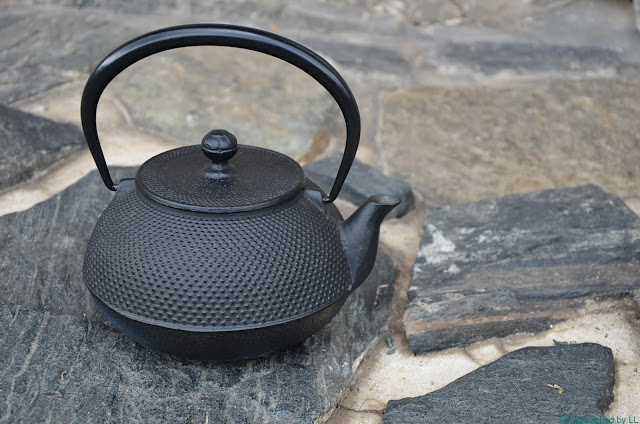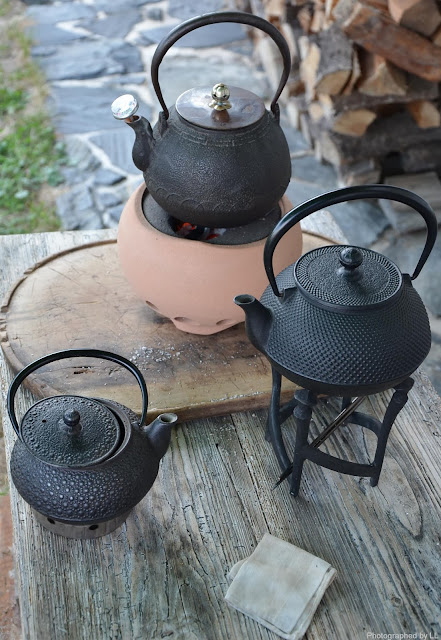Srovnání tetsubin
Existuje spousta nádob vhodných pro ohřev vody na čaj - rychlovarnou konvicí počínaje a třebas kotlíkem nad ohněm konče. Možnosti jsou široké. Každou nádobu popisujeme jejími vlastnostmi. Tyto vlastnosti (obvykle dobré, špatné a nestranné) jsou pro každého člověka osobité - co někomu vadí, může jiného zaujmout. A možná i proto o jednotlivých nádobách koluje spousta názorů, proč jsou špatné, proč jsou dobré, jak z nich chutná voda nebo proč je tamta jiná nádoba lepší.
Já nejraději ohřívám vodu v tetsubin. Mám rád směr jakým tetsubin mění chuť vody a poté i čaje. Jak už je u mě ale zvykem, chtěl jsem zjistit, zda je ona lepší chuť pouze obrazem mé představivosti, nebo zda je to skutečnost. Zkoušet vlastnosti tetsubin není v čechách zrovna jednoduché, obzvláště pokud jich potřebujete více najednou. Tetsubin zde nemají historicko kulturní vazby, pro laického evropana jsou předražené a pro dnešní hektický způsob života obtížně uchopitelné. Jsem z malého města a o žádné další tetsubin nevím. V létě se na mě ale usmálo štěstí. Díky čajovým přátelům se mi podařilo shromáždit tři tetsubin. Každá tetsubin se lišila stářím, zpracováním, kvalitou a i informacemi, které jsme o ní věděli nebo předpokládali - dokonalý soubor pro pokus.
Začneme jedním příběhem. Kdysi se jeden přispěvovatel čajového fóra Tea Earth pln radosti pochlubil svojí novou tetsubin zakoupenou pro ohřev vody. Při čištění ale uvnitř narazil na vrstvu čehosi, co určil jako smalt a o toto zjištění se s námi podělil. Myslím si, že toho později litoval, protože jsme ho hromadně ujistili, že vzhledem k smaltu nekoupil kvalitní tetsubin na ohřev vody ale levnější verzi vhodnou pouze pro přípravu čajového nálevu. A byli jsme tak laskaví, že jsme ho o tom opakovaně ujišťovali pořád a pořád dokola až sám pronesl, cituji: „Již jsem se smířil s tím, že je víceméně pouze na ozdobu. Holt to nebyla moc dobrá koupě.“ Později jsme se domluvili na společném čajování. Nejdříve nechtěl, ale povedlo se mi ho přemluvit, aby svoji tetsubin přivezl. Měl jsem v plánu porovnat vodu ze smaltované a nesmaltované litinové konve. A tady ji máme - označím ji jako Neznámá.
Vnější umělecké ztvárnění tetsubin potěší oko ale nikoliv jazyk. Pro chuť vody je důležitý vnitřek.
Jedná se o menší tetsubin o objemu půl litru. Zdobená je variací vzoru Arare 霰. Provedení držátka konve i držátka víčka odpovídá nižší kvalitě řemeslného zpracování. Sklopné držátko konve je výhodné při přepravě. V tomto případě je ale již tak vyviklané, že nedrží ve svislé poloze a tím narušuje umělecký dojem konve. Také víčko sedí velmi volně. Výrobce ani stáří konve není známo - byla zakoupena jako: “japonská litinová konev z poloviny 20. století“. Díky menší velikosti působí poněkud roztomile. Jakmile jsem ji poprvé dostal do ruky, tak jsem nakoukl dovnitř. Byl jsem šťastný i smutný zároveň. Barva a způsob reznutí litiny totiž jasně prokazují, že se jedná o nesmaltovaný tetsubin! Plán srovnat smalt a nesmalt vzal rychle za své. Na druhou stranu jsem potěšil kamaráda a tetsubin tedy neskončí na poličce jako pouhopouhá ozdoba.
A nyní k mé tetsubin - označím jako Nová. Po dlouhém váhání jsem ji zakoupil přímo z Japonska. Byla to koupě naslepo. Tehdy jsem nevěděl, jak voda z tetsubin chutná. Dnes jsem velmi spokojen.
Jedná se o novou tetsubin od firmy Iwachu vyrobenou kolem roku 2012. Obě držátka opět poukazují na nižší kvalitu zpracování. Zdobená je nejznámějším prostým vzorem Arare 霰. Pro zlepšení antikorozních vlastností vnějšku je tento opatřen nátěrem z rostliny urushi. Bodové reznutí (po roce užívání), barva rzi a barva litiny odpovídají klasickému nesmaltovanému tetsubin. Víčko sedí opět volněji. Objem konve je 1,3 litru. Držátko konve je sklopné a zatím drží v jakékoliv poloze.
A pak zde máme třetí tetsubin - označím jako Krásnou.
Již na první pohled je zřejmé, že se od předchozích dvou liší. Dle prodejce se jedná o starožitnou tetsubin z období Šówa s udávaným stářím 82 let. Konev je signována jako RYV-BON-DOH. Zpracování držátka konve a víčka odpovídá kvalitnějšímu zpracování. Objem je 1,3 litru. Vnitřek je zcela pokryt rzí a to včetně hubičky. Nadbytek rzi může být způsoben jejím dlouhodobým nepoužíváním před prodejem - těžko ale soudit. Nyní, asi po stém! vyvaření vodou, se zdá, že se začíná objevovat povrch původní litiny. Opět jsem tedy přesvědčen, že se jedná o tradičně zpracovaný nesmaltovaný tetsubin. Vnějšek je zdoben vzorem Hada 肌 s přidáním geometrických obrazců.
Původní záměr srovnat smalt a nesmalt bohužel nevyšel. Shromáždili jsme ale tři poměrně odlišné tetsubin a proto jsme se rozhodli porovnat jejich vliv na uvařenou vodu a čaj.
Nejdříve jsme porovnávali samotnou vodu. K ohřevu jsme použili kamínka na dřevěné uhlí. Z prvních dvou konví jsme vodu přelili do vyhřátých termosek. Všechny vzorky jsme nalili současně do testerů ihned poté, co začala vřít voda v poslední tetsubin. Jednalo se samozřejmě o slepý test.
Asi nikoho nepřekvapí, že vzhledově se vzorky nelišili. Testery označím zleva jako jedna až tři. Voda z prvního a druhého testeru mi přišla téměř totožná. Mírný rozdíl jsem postřehl u třetího vzorku. Rozdíly byly ale tak minimální, že jsem je nedokázal jakkoliv seřadit. Ony drobné rozdíly byly nejzřetelnější na první ochutnání, následná ochutnání již spíše mátla.
Druhý ochutnávající (s vynikající “rozlišující“ chutí) určil jako nejhorší vzorek dva a zbylé označil za srovnatelné.
Poslední ochutnávající postřehl také pouze nepatrné rozdíly. Nepatrnost rozdílů v chuti vzorků nejlépe vystihují jeho slova po druhém ochutnání, cituji: „Hm, tak teď už opravdu necítím vůbec nic. To je v prdeli“.
Shodli jsme se, že voda ze všech tetsubin chutná jakoby “sladce“. Drobné rozdíly jsme zaznamenali všichni, ale pokud mě paměť neklame, tak pouze jeden z nás je byl schopen s jistotou seřadit od nejhoršího po nejlepší. Vlevo je voda z Nové, uprostřed z Krásné a vpravo z Neznámé tetsubin. Jako nejhorší byla označena voda z Krásné. Tato tetsubin byla nejvíce zrezlá.
Dále jsme zkusili porovnat čajové nálevy. Pro jemnost a vyváženost její chuti jsme zvolili Bílou Pivoňku. Opět se jednalo o slepou zkoušku.
Na fotografii sice vypadají nálevy vlevo tmavší, ale ve skutečnosti byla barva a vůně nálevů totožná. Při prvním ochutnání jsme postřehli drobné rozdíly, druhé nás opět zmátlo. Čaj ony rozdíly ještě více zjemnil. Nejodlišněji chutnal nálev z tetsubin Krásné. Jenže tento nálev byl jednou označen jako nejhorší, jednou jako nejlepší a jednou něco mezi. Každý z nás seřadil nálevy jinak. Nejzkušenější ochutnávač ovšem nálev z Krásné označil opět jako nejhorší.
Ještě zmíním, že vzhledem k nedostatku skleněných termosek, jsme použili i jednu kvalitní nerezovou. Shodou okolností v ní byla voda z Krásné tetsubin. Používám ji přes tři roky a nezaznamenal jsem, že by ovlivňovala chuť vody. Týden před zkouškou byla vyčištěna. Ostatní ochutnávající ale měli mírné pochybnosti.
Zjistili jsme, že voda ze zkoušených tetsubin chutnala velmi podobně - “sladce“. Postřehnuté rozdíly byly velmi nepatrné. Předpokládám, že tyto rozdíly souvisí s tím, jak moc je povrch tetsubin zrezlý. Určíté množství rzi je u těchto konví “žádané“ - všeho moc ale škodí. K tomuto předpokladu mě, mimo jiné, vedou doporučení výrobců, jak tetsubin používat aby příliš nezrezly. A také mnoho internetových diskuzí, jak zrezlé tetsubin vyčistit, protože voda z nich chutná “archivně“. K potvrzení tohoto předpokladu bychom ale potřebovali více tetsubin a mnohem více zkoušek. Snad někdy příště.
Všem ochutnávajím děkuji za dovezení tetsubin, jejich názory a postřehy a hlavně za krásný čajový den.
Všem ochutnávajím děkuji za dovezení tetsubin, jejich názory a postřehy a hlavně za krásný čajový den.

















